Lobostemon
Lobostemon Lehm.
Family: Boraginaceae
Common names: pajama bush
Introduction
This endemic genus, with numerous species of densely flowered, attractive shrubs, provides a splash of colour in the early spring, long before other popular garden plants are in bloom.

Description
Description
Perennial shrubs with leaves alternate, hairless or hairy. Flowers mostly bell-shaped; sepals 5, mostly free, often dissimilar in size; petals 5, hairy or glabrous on the outside. Stamens 5, similar or dissimilar in length and exserted or included in adult flowers; staminal scales well developed or reduced to ridges or mere swellings and hairy; filaments free from petals or variously fused above staminal scales. Closely related to Echiostachys Lehm. and Echium L.
Conservation Status
Status
A number of species are viewed to be threatened, e.g. Lobostemon belliformis known only from about 30 individuals growing in one locality near Gouritz. The main threat appears to be the destruction of natural habitat due to agricultural activities.
Distribution and habitat
Distribution description
Twenty-eight species are endemic to South Africa, largely confined to the winter rainfall area from Springbok to Mossel Bay, and further eastward along the coast to about Grahamstown, where rain occurs throughout the year.
Derivation of name and historical aspects
History
The genus name is derived from the Latin, lobos, meaning lobe, and the Greek word stemon, meaning stamen. The species Echium plantagineum (bloudissel) introduced from Europe, is locally frequent in disturbed areas and colour many fallow agricultural fields blue in the Boland when flowering in spring. In England this species is known as viper's bugloss and in Australia where it is also a serious weed, Paterson 's curse. J.G.C. Lehmann established the genus in 1830 to separate it from Echium, placing emphasis on the presence of so-called staminal scales in Lobostemon.

Ecology
Ecology
Plants resprout especially after fire and are mostly insect-pollinated, with the red-flowered species bird-pollinated.
Uses
Use
Lobostemon fruticosus, known to most rural folk in the Western Province, is used especially for treating wounds, blood poisoning, ringworms, skin diseases and syphilis. The remedies all require an infusion of the leaves, or a paste is made by either pounding the leaves or chewing them-the slimy paste is then topically applied to the affected area.
Growing Lobostemon
Grow
See Lobostemon fruticosus for notes on growing Lobostemon.
Species
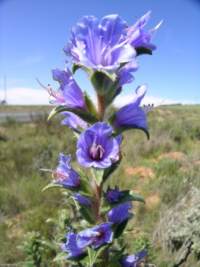
Lobostemon argenteus
The leaves are lanceolate to ovate in shape and possess long and short hairs. The inflorescence is cymous (the topmost bloom flowers first), restricted to two flowers per cyme. The flowers are medium in size (rear petals being 17-30 mm long), bell-shaped and fused below to form a tube; the 5 sepals are lanceolate in shape; dissimilar in width, shorter than half of corolla tube as well as unfused to each other; the 5 petals are predominantly violet-blue and hairless on the outside. The 5 stamens are shortly fused with the petals; the staminal scales occur well below the entrance of the corolla tube, are reduced to ridges and do not possess lateral lobes. Styles are hairy.
Lobostemon argenteus flowers mainly from August to November, although flowering specimens have been collected as late as April in the Caledon region It exhibits a disjunct distribution, occurring in three distinct regions. Current field work has resulted in re-collections within the boundaries of the Western Cape.Attempts to re-collect in the Kamiesberg vicinity and near Grahamstown have failed. The present disjunct distribution of L. argenteus is probably indicative of a once widespread distribution.
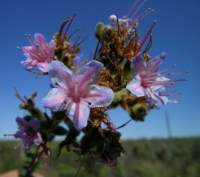
Lobostemon echioides
The leaves are narrowly oblong, lanceolate or ovate in shape and possess hairs similar in length. The inflorescence is cymous, with a large number of flowers per cyme. The flowers are small in size (rear petals less than 17 mm long), rotate in shape and fused below to form a corolla tube; the 5 sepals are lanceolate in shape, similar in width; and shorter than half of corolla tube as well as unfused to each other; the 5 petals are predominantly violet-blue and hairy on the outside (hairs largely confined to petal lobes). The 5 stamens are free from the petals above staminal scales; the staminal scales occur near the entrance of the corolla tube and are well developed, possessing lateral lobes. Styles are hairless.
Lobostemon echioides flowers mainly from August to October, but collections of flowering specimens have been made throughout the year. Plants flowering from February to May, appear to be confined to the southern parts of the species distribution range. This region often receives rain throughout the year (although in limited quantities). It is one of the most successful species in the genus from a distributional point of view, occurring almost throughout the entire total distribution range of the genus.
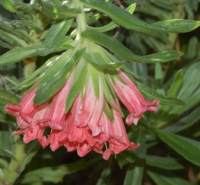
Lobostemon belliformis
The leaves are oblanceolate in shape and possess hairs similar in length. The inflorescence is cymous, with a large number of flowers per cyme. The flowers are large (rear petals longer than 30 mm); tubular in shape and fused below to form a corolla tube; the 5 sepals are oblong in shape, similar in width with two to four sepals partly fused; the 5 petals are predominantly pink to red and hairy on the outside. The 5 stamens are fused to the petals above staminal scales (for 5 mm or longer); staminal scales occur well below the entrance of the corolla tube. They are reduced to mere swellings and do not possess lateral lobes. Styles are hairy.
The plants grow mainly on stabilized sand dunes near Gouriqua, flowering from September to middle October. The showy and abundant red flowers attract birds, particularly the Orangebreasted and Lesser Doublecollared Sunbirds ( Nectarina violacea and N. chalybea ) as well as the Cape Sugarbird ( Promerops cafer ). See more about this plant.
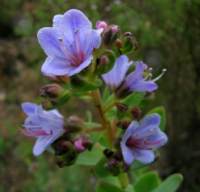
Lobostemon glaucophyllus
The leaves are lanceolate or oblanceolate in shape and possess hairs that are similar in length. The inflorescence is cymous, with a large number of flowers per cyme. The flowers are small (rear petals less than 17 mm long), bell-shaped and fused below to form a corolla tube; the 5 sepals are lanceolate, similar in width; and unfused to each other; the 5 petals are predominantly violet-blue and hairless on the outside. The 5 stamens are shortly fused to the petals above the staminal scales (less than 5 mm); staminal scales occur well below the entrance of the throat of the corolla tube and are well developed and possess lateral lobes. Styles are hairy.
Lobostemon glaucophyllus flowers mainly from July to November. It is widespread, occurring from Nieuwoudtville in the north to Franschoek in the south and as far as Gamka Mountain Nature reserve in the east. It frequently occurs on granitic soils towards the southern reaches of its distribution range, but also occurs in the more limey soils of the Sand Plain Fynbos as well as sandstone soils of the Mountain Fynbos vegetation.
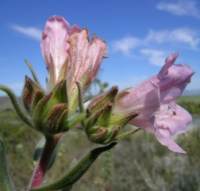
Lobostemon curvifolius
The leaves are narrowly oblong to oblanceolate in shape and possess hairs similar in length. Inflorescence is cymous, with a large number of flowers per cyme. The flowers are large (rear petals longer than 30 mm), bell-shaped and fused below to form a corolla tube; the 5 sepals are oblong, similar in width and unfused to each other; the 5 petals are predominantly violet-blue, or pink and hairy on the outside. The 5 stamens are shortly fused to the petals above staminal scales (less than 5 mm); staminal scales occur well below the entrance of the corolla tube, are reduced to ridges and do not possess lateral lobes. Styles are hairy.
Lobostemon curvifolius flowers mainly from August to October. The species does not appear to be confined to a single soil or vegetation type and occurs from Houw Hoek to Cape Infanta. In the western parts of its distribution range, it is mainly found in the Mountain Fynbos vegetation. Over the remaining distribution range it occurs mainly in South and South-west Coast Renosterveld. Limited collections have also been made in the Limestone Fynbos in the De Hoop area.
References
- Buys, M.H. 1997. A systematic revision of Lobostemon (Boraginaceae).Unpublished Ph.D. thesis, University of Stellenbosch.
- Buys, M.H. 2000. Lobostemon.In P. Goldblatt & J.C. Manning, Cape plants. A conspectus of the Cape flora of South Africa.Strelitzia 9. National Botanical Institute, Cape Town.
- Buys, M.H. 2006. A morphological cladistic analysis of Lobostemon (Boraginaceae). South African Journal of Botany 72: 383-390.
- Roberts, M. 1990. Indigenous healing plants. Southern Book Publishers, Pretoria.
Credits
Matt H. Buys
Compton Herbarium
October 2006
Plant Attributes:
Plant Type: Shrub
SA Distribution:
Soil type:
Flowering season:
PH:
Flower colour:
Aspect:
Gardening skill:
Special Features:
Horticultural zones







Rate this article
Article well written and informative
Rate this plant
Is this an interesting plant?
Login to add your Comment
Back to topNot registered yet? Click here to register.